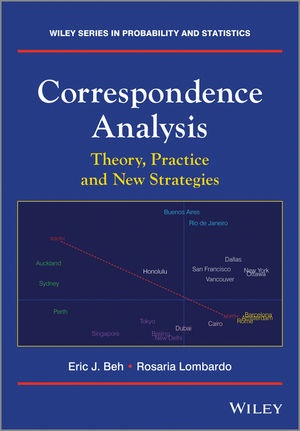Read more
A comprehensive overview of the internationalisation of correspondence analysis
Correspondence Analysis: Theory, Practice and New Strategies examines the key issues of correspondence analysis, and discusses the new advances that have been made over the last 20 years.
The main focus of this book is to provide a comprehensive discussion of some of the key technical and practical aspects of correspondence analysis, and to demonstrate how they may be put to use. Particular attention is given to the history and mathematical links of the developments made. These links include not just those major contributions made by researchers in Europe (which is where much of the attention surrounding correspondence analysis has focused) but also the important contributions made by researchers in other parts of the world.
Key features include:
* A comprehensive international perspective on the key developments of correspondence analysis.
* Discussion of correspondence analysis for nominal and ordinal categorical data.
* Discussion of correspondence analysis of contingency tables with varying association structures (symmetric and non-symmetric relationship between two or more categorical variables).
* Extensive treatment of many of the members of the correspondence analysis family for two-way, three-way and multiple contingency tables.
Correspondence Analysis offers a comprehensive and detailed overview of this topic which will be of value to academics, postgraduate students and researchers wanting a better understanding of correspondence analysis. Readers interested in the historical development, internationalisation and diverse applicability of correspondence analysis will also find much to enjoy in this book.
List of contents
Foreword xv
Preface xvii
Part One Introduction 1
1 Data Visualisation 3
1.1 A Very Brief Introduction to Data Visualisation 3
1.2 Data Visualisation for Contingency Tables 10
1.3 Other Plots 12
1.4 Studying Exposure to Asbestos 13
1.5 Happiness Data 25
1.6 Correspondence Analysis Now 29
1.7 Overview of the Book 34
1.8 R Code 35
References 36
2 Pearson's Chi-Squared Statistic 44
2.1 Introduction 44
2.2 Pearson's Chi-Squared Statistic 44
2.3 The Goodman--Kruskal Tau Index 51
2.4 The 2 × 2 Contingency Table 52
2.5 Early Contingency Tables 54
2.6 R Code 61
References 67
Part Two Correspondence Analysis of Two-Way Contingency Tables 71
3 Methods of Decomposition 73
3.1 Introduction 73
3.2 Reducing Multidimensional Space 73
3.3 Profiles and Cloud of Points 74
3.4 Property of Distributional Equivalence 79
3.5 The Triplet and Classical Reciprocal Averaging 79
3.6 Solving the Triplet Using Eigen-Decomposition 84
3.7 Solving the Triplet Using Singular Value Decomposition 86
3.8 The Generalised Triplet and Reciprocal Averaging 89
3.9 Solving the Generalised Triplet Using Gram--Schmidt Process 91
3.10 Bivariate Moment Decomposition 100
3.11 Hybrid Decomposition 100
3.12 R Code 103
3.13 A Preliminary Graphical Summary 109
3.14 Analysis of Analgesic Drugs 112
References 115
4 Simple Correspondence Analysis 120
4.1 Introduction 120
4.2 Notation 121
4.3 Measuring Departures from Complete Independence 122
4.4 Decomposing the Pearson Ratio 124
4.5 Coordinate Systems 126
4.6 Distances 136
4.7 Transition Formulae 140
4.8 Moments of the Principal Coordinates 141
4.9 How Many Dimensions to Use? 145
4.10 R Code 147
4.11 Other Theoretical Issues 154
4.12 Some Applications of Correspondence Analysis 156
4.13 Analysis of a Mother's Attachment to Her Child 158
References 165
5 Non-Symmetrical Correspondence Analysis 177
5.1 Introduction 177
5.2 The Goodman--Kruskal Tau Index 180
5.3 Non-Symmetrical Correspondence Analysis 186
5.4 The Coordinate Systems 188
5.5 Transition Formulae 197
5.6 Moments of the Principal Coordinates 199
5.7 The Distances 201
5.8 Comparison with Simple Correspondence Analysis 204
5.9 R Code 204
5.10 Analysis of a Mother's Attachment to Her Child 209
References 212
6 Ordered Correspondence Analysis 216
6.1 Introduction 216
6.2 Pearson's Ratio and Bivariate Moment Decomposition 221
6.3 Coordinate Systems 222
6.4 Artificial Data Revisited 233
6.5 Transition Formulae 236
6.6 Distance Measures 238
6.7 Singly Ordered Analysis 239
6.8 R Code 241
References 248
7 Ordered Non-Symmetrical Correspondence Analysis 251
7.1 Introduction 251
7.2 General Considerations 252
7.3 Doubly Ordered Non-Symmetrical Correspondence Analysis 254
7.4 Singly Ordered Non-Symmetrical Correspondence Analysis 257
7.5 Coordinate Systems for Ordered Non-Symmetrical Correspondence Analysis 259
7.6 Tests of Asymmetric Association 265
7.7 Distances in Ordered Non-Symmetrical Correspondence Analysis 266
7.8 Do
About the author
Eric J. BehSchool of Mathematics & Physical Sciences, University of Newcastle, Australia
Rosaria LombardoDepartment of Economics, Second University of Naples, Italy
Summary
A comprehensive overview of the internationalisation of correspondence analysis Correspondence Analysis: Theory, Practice and New Strategies examines the key issues of correspondence analysis, and discusses the new advances that have been made over the last 20 years.

